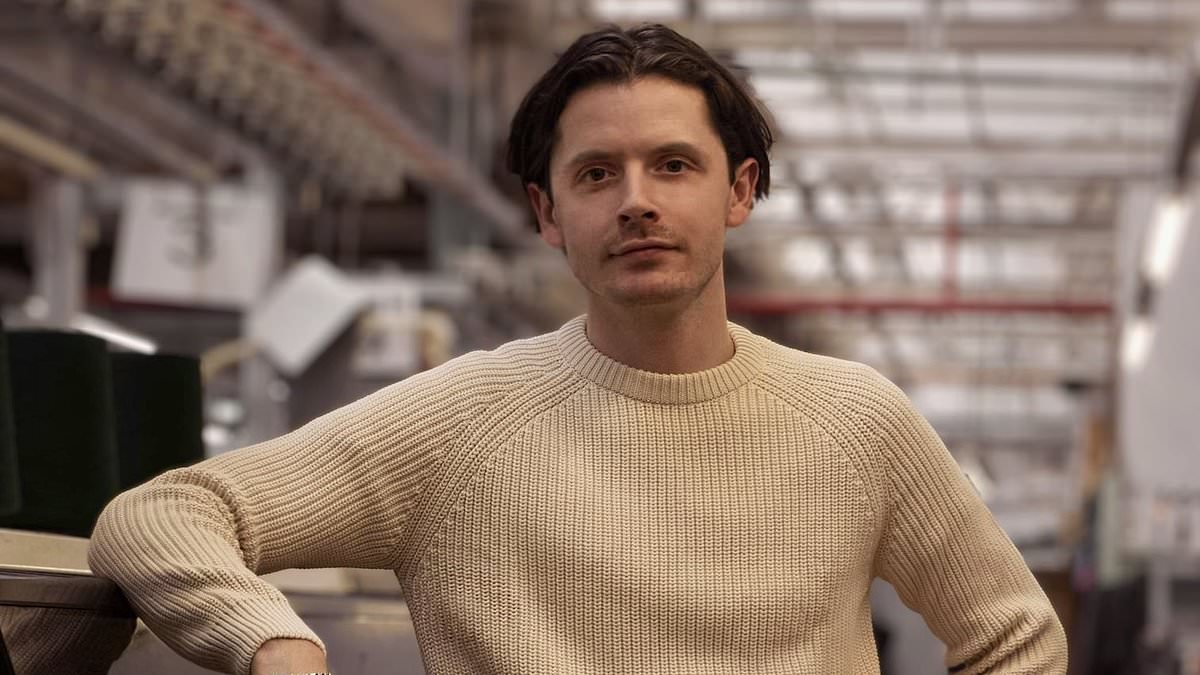Drugs that can edit and rewrite DNA are set to banish problems ranging from high cholesterol to blood cancer – ushering in what experts have deemed the greatest medical breakthrough since antibiotics.
For example, the pioneering treatment has already been used to combat a number of previously incurable conditions. Earlier this month the NHS pledged to roll out a £1.7 million therapy for sufferers of a rare blood disorder – and more are on the way.
The Mail on Sunday can reveal that drugs for hereditary heart disease, leukaemia and urinary tract infections have shown ground-breaking results in trials and could be available to millions of patients within just three years.
‘Gene-editing therapies are the future of medicine,’ said Professor Robin Lovell-Badge, a genetics expert at the Francis Crick Institute. ‘If they really do provide a cure for these diseases – and all expectations are that they will – they’re a one-off treatment that lasts a lifetime. We could give patients their lives back.’

One patient who has already benefited from gene-editing therapy is 31-year-old Elliot Mason, who was born with severe haemophilia B
But as these medications become more widespread, other experts are raising concerns around their safety – and how genetic modification will impact generations to come.
One patient who has already benefited from gene-editing therapy is 31-year-old Elliot Mason, who was born with severe haemophilia B. The rare inherited blood clotting disorder was famously suffered by the Russian Romanov royal family as well as three of Queen Victoria’s children.
It meant Elliot’s body couldn’t make enough of a crucial protein that helps blood to clot after injuries. Growing up, he was unable to do certain sports for fear of getting hurt and needed three injections a week to keep his clotting levels high enough.
‘Managing my condition day-to-day caused me a lot of stress as a teenage boy,’ said Elliot, from London. ‘I was always having to go off to take my medication and constantly had needle marks in my arms.’
Then, six years ago, he was offered the chance to participate in a gene therapy trial at the Royal Free Hospital in north London.
‘After a few weeks of paperwork and testing, I finally came in for the appointment. They gave me an IV infusion drip that took just under an hour,’ he explained.
‘I didn’t feel any physical impact at the time, but within the first month the levels of the blood clotting protein in my liver began to rise.
‘Since then I’ve not needed to take any medication. I’m free of even thinking about my condition.’
So what are these drugs that can locate and edit out minute errors in DNA – and why are they controversial?

Drugs that can edit and rewrite DNA are set to banish problems ranging from high cholesterol to blood cancer, ushering in what experts have deemed the greatest medical breakthrough since antibiotics
Scientists have been working to cure genetic disorders by changing patients’ cells since the 1960s. But it wasn’t until the last decade that gene-editing really took off – spurred by the discovery of the CRISPR-Cas9 system. CRISPR – clustered regularly interspaced short palindromic repeats – allows sections of faulty DNA inside cells to be manipulated.
The technology is often likened to a pair of molecular scissors, that can seek out a specific strand of DNA and snip pieces off.
Researchers discovered that many forms of bacteria use a protein called Cas9 to fight off invading viruses. It does this by entering the virus and breaking-up its DNA, neutering its attacks.
Over years of research, scientists were able to replicate and control this protein for use in the human body.
This is done by placing the protein inside a harmless virus which then seeks out the faulty DNA strands. In laboratory trials, they were able to detect and replace the abnormalities in patients’ DNA that caused genetic conditions such as sickle
cell anaemia and haemophilia. When CRISPR was used in human trials involving thousands of patients, it was shown to be safe and highly effective.
And unlike existing treatments – which often require regular hospital visits and life-long medication – gene-editing therapies can be given in a one-off transfusion.
The revolutionary new treatment for the blood disorder beta thalassaemia, approved by the NHS spending watchdog NICE despite its £1.7 million price tag, uses CRISPR technology to fix errors in the genes responsible for producing haemoglobin – the protein in red blood cells that carries oxygen throughout the body.
Patients with the condition cannot produce enough haemoglobin, meaning their vital organs are deprived of oxygen, which can lead to early death. But more than nine in ten patients given the new CRISPR drug – known as Casgevy – saw their haemoglobin levels rise to a healthy level.
‘It’s amazing when you think that these methods were only discovered in 2012 – in just 12 years we have clinical trials and treatments that are now approved,’ said Professor Lovell-Badge.
‘Each case is complex – these are very expensive treatments because of all the requirements needed to ensure their safety.
‘But gene editing is definitely the way forward.’
More than 150 trials are currently using the technology to treat conditions ranging from eye deterioration to metabolic diseases. And while not all will ultimately be successful, a fair few likely will, according to Professor Lovell-Badge.
‘We’re going to see others coming through for approval by regulatory bodies in the next three years – and these will gradually increase in number,’ he said.
And it’s not just inherited genetic conditions that CRISPR technologies may be able to cure. ‘There are scientists working on treatments to eliminate HIV and certain cancers using similar methods,’ said Professor Lovell-Badge.
Blood cancers in particular carry great potential for CRISPR cures. A 13-year-old girl with ‘incurable’ T-cell leukaemia became the first patient in the world to receive base-edited cells, at London’s Great Ormond Street Hospital, in 2022. Alyssa, from Leicester, had received all the conventional therapies – including chemotherapy and a bone marrow transplant.
With no other options, doctors injected her with genetically modified T-cells – defensive white blood cells that protect the body from infections – from a healthy donor that had been reprogrammed to hunt down and kill the cancerous cells in her system.
Just 28 days later, Alyssa was in remission.
Now 15, she is cancer free and grateful for the ‘amazing’ trial that saved her life. She said: ‘I am so happy to be here right now. It’s not just that I can do all the things that I thought I was never going to be able to do again, but I can bring hope to other people.’
Other promising treatments being researched include using CRISPR to cure a genetic form of high cholesterol, called familial hypercholesterolemia. The life-threatening condition, which drastically raises the risk of heart attacks and strokes, affects about 220,000 people in the UK. Less than a tenth of patients realise they have it.

While trials such as these promise amazing results, some experts remain sceptical about the safety of gene-editing therapies
Radical new drug Verve-101 promises to permanently lower cholesterol by deleting a hereditary flaw which cause extremely high amounts of the fatty substance in the blood. In early human trials, scientists hope the medication will be available in the UK by 2028.
While trials such as these promise amazing results, some experts remain sceptical about the safety of gene-editing therapies.
Dr Tony Lockett, a rare diseases expert and lecturer at King’s College London, believes there are a number of serious risks to CRISPR. He claims that inserting genetically modified cells into the body could raise the risk of cancer. There is also the danger that the virus used to deliver the CRISPR may damage the patient.
In 1999, an 18-year-old US gene therapy trial participant, Jesse Gelsinger, who had a genetic liver disease, died after reacting to the cold virus used in his treatment.
Any gene-editing therapy also runs the risk of mosaicism – a potentially deadly condition that occurs when someone has two or more genetically different sets of cells in their body.
Finally, any drug that treats cells in the bone marrow – as Casgevy does – requires existing bone marrow cells to be eradicated before the new ones are added back in. To do this, patients are given medications that can sometimes cause infertility as well making them very ill.
‘In areas such as motor neuron disease and dementias – where the life expectancy is low and pretty miserable – the risks aren’t as prominent,’ Dr Lockett explained.
‘But it begs the question: how severe does the disease need to be before we risk giving the patient gene-editing treatment?’
In the future, questions around the ethics of using CRISPR technology could become even more complex. In 2019, a Chinese scientist was imprisoned for genetically modifying twin babies, but experts
say gene-editing babies before they’re born could become commonplace in the UK as the therapy takes off with adults.
‘Soon we’ll have a number of patients who have successfully had gene-editing treatment themselves but who can still pass the faulty genes on to their children,’ said Professor Lovell-Badge. ‘So in the future there will be much more demand for inheritable gene editing than now.’
Dr Lockett agreed that offering the drug to patients will, at times, be a fraught decision: ‘It’s a wonderful technology but it does raise safety and economic issues, which could keep gene-editing therapies from truly taking off.’
Whatever the rights or wrongs, former haemophilia B patient Elliot Mason feels lucky to have received gene editing. ‘It’s a massive mental burden that’s been lifted,’ he said. ‘Getting the treatment has been one of the best things I’ve ever done.’










